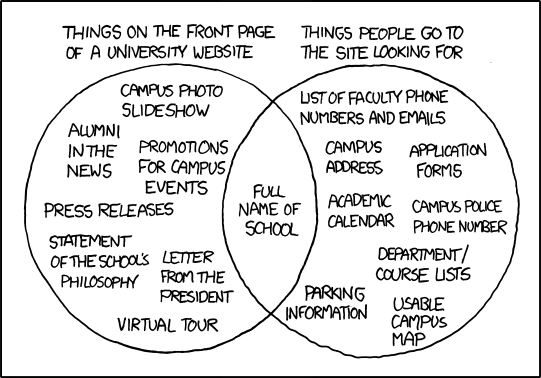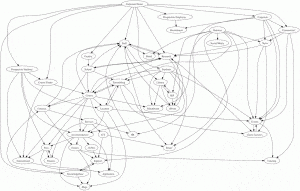Following on from my post about the URI structure in our existing corporate website I’m now taking a brief look at a number of other websites and web applications that we have at the University, WordPress, Blackboard (blackboard.lincoln.ac.uk), SharePoint 2003 (internal – portal.lincoln.ac.uk, external – visit.lincoln.ac.uk) and Posters at Lincoln (posters.lincoln.ac.uk).
WordPress
blogs.lincoln.ac.uk
We have an active blogging community here at Lincoln with over 400 registered blogs running on a WordPress MU install. WordPress has built in friendly URIs (permalinks in WordPress terminology) so I was expecting to see a good proportion of blogs that had a good URI structure.
I wrote a script – https://gist.github.com/890378 – which simply grabs the permalink structure for each registered blog so that I can see an aggregated view of the settings that have been set up for each blog.
Here are the results:
| Permalink structure | Number of blogs |
| /%year%/%monthnum%/%day%/%postname%/ | 404 |
| /%postname%/ | 8 |
| no permalink structure | 3 |
| /%year%/%postname%/ | 2 |
| /articles/%postname%/ | 1 |
| /%year%/%monthnum%/%postname%/ | 1 |
| /%monthnum%/%year%/%postname%/ | 1 |
96% of blogs are running with the default permalink structure which basically means you have URIs that looks like http://example.blogs.lincoln.ac.uk/2011/03/22/hello-world. In terms of readability this does result in URIs that can be easily understood. As for predictability of a specific post’s URI then I think you’re perhaps better off doing a search from the blog’s home page. I did a Google search for “thoughts on WordPress permalinks” and there seems to be a consesus that the default permalink structure is “good enough” SEO wise however there are performance gains by using it over %postname% because it reduces the number of queries WordPress has to do internally to return the correct post.
Blackboard
blackboard.lincoln.ac.uk
The interface of Blackboard comprises of a HTML frameset page which if you read the source code actually explains itself:
“The Blackboard Academic Suite environment includes a header frame with images and buttons customized by the institution and tabs that navigate to different areas within Blackboard Academic Suite. Clicking on a tab will open that area in the content frame. Web pages containing specific content, features, functions, and tools are accessed from the tab areas.”
Basically this means that the home page, regardless of whether or not you’re signed into Blackboard or not is always http://blackboard.lincoln.ac.uk/webapps/portal/frameset.jsp and it also means you can’t directly link to a Blackboard resource (as I’m about to without screwing up the interface). You could say this doesn’t matter at all from an SEO stand point because resources aren’t externally available however I’m can’t help sympathising with someone trying to explain how to access a Blackboard resource over the phone; I’d imagine it would go something like “click on this, now that, now sign in, now click the top link in the list on the left, now select you the course you want, then this, that and you should now see what you want”, as opposed to “just click on the link I’ve just sent you”.
Taking the above into consideration (i.e. that Blackboard links are essentially irrelevant to the end user) it is interesting to see what some Blackboard URIs look like:
| Blackboard Module | URI |
| Announcements | http://blackboard.lincoln.ac.uk/bin/common/announcement.pl?action=LIST&context=mybb&scope=_all |
| View Grades | http://blackboard.lincoln.ac.uk/webapps/gradebook/do/student/viewCourses |
| Community | http://blackboard.lincoln.ac.uk/webapps/portal/tab/_3_1/index.jsp |
| Logout | https://blackboard.lincoln.ac.uk/webapps/login?action=logout |
| Help | http://blackboard.lincoln.ac.uk/webapps/portal/frameset.jsp?tab_id=_40_1 |
| Example course | http://blackboard.lincoln.ac.uk/bin/common/course.pl?course_id=_46268_1 |
| Course blog | http://blackboard.lincoln.ac.uk/webapps/blackboard/content/listContent.jsp?course_id=_46250_1&content_id=_444545_1&mode=reset |
| Supervisor wiki | http://blackboard.lincoln.ac.uk/webapps/lobj-wiki-bb_bb60/wiki_home/Handler?course_id=_32711_1&content_id=_457614_1 |
A few URIs seem mildly related to their content such as the example course and the gradebook however others like the community home page almost seem random.
SharePoint 2003
portal.lincoln.ac.uk (interal) visit.lincoln.ac.uk (external)
Our SharePoint 2003 installation is our institution’s internal content repository and intranet. Every department and faculty has it’s own “site” (read: section) and providing you know exactly what you are looking for (searching doesn’t work) then it is generally quite useful. Unlike Blackboard however SharePoint is not built using frames and so you can give out direct links to content, for example:
| Resource | URI |
| ICT department | https://portal.lincoln.ac.uk/C15/CS/default.aspx |
| University Resource | https://portal.lincoln.ac.uk/C17/UniversityResources/default.aspx |
| First aiders | https://portal.lincoln.ac.uk/C11/C0/First%20Aiders/default.aspx |
| External news | https://portal.lincoln.ac.uk/External%20News/default.aspx |
| FreeCycle | https://portal.lincoln.ac.uk/C13/C18/Freecycle/default.aspx |
At first glance the SharePoint URIs look as random as Blackboard’s however I’ve had explained to me why this is. Basically SharePoint is made up of “sites”. In the 2003 version the first 20 sites can be named whatever you want, for example “External News” or “University Resources” however after that SharePoint insists on using folders that count up, prefixed with the letter “C”, e.g. C0, C1, C2, and so on up to C19. Inside these “sites” again you can have another 20 directories named whatever you want and then the C directories start. This basically means that sites are capped at 40 directories per directory, half of which you can alter the name. Confusing yes. Logical no. I’ve been informed that this is no longer the case in SharePoint 2007 onwards.
As a result you can potentially have sites that have a nice friendly URI structure (if you discount the /default.aspx at the end) e.g. https://portal.lincoln.ac.uk/Examples/HelloWorld/default.aspx. However for sites which are granted C-directories (such as the ICT department) the URL loses all contextual relevance. Again I think the best bet for users is to follow links through to the resource (or if they’re feeling brave, try searching for the content).
Posters at Lincoln
posters.lincoln.ac.uk
Posters at Lincoln was one of the first sites I worked on when I started working for the Online Services Team here at the University. It’s development brought about the Common Web Design and a number of other projects we’ve worked on over the last year. Therefore forgive me if I’m a bit bias in this overview.
The site is split up into “groups”, such as ICT Department or Marketing and Communications, and “campaigns”, which are posters created for different events and public notices.
We designed the URI structure to be SEO friendly and semantically relevant with URLs like:
| Resource | URL |
| Home page | http://posters.online.lincoln.ac.uk/home |
| About page | http://posters.lincoln.ac.uk/about |
| All campaigns | http://posters.lincoln.ac.uk/all |
| Marketing and Communications group | http://posters.lincoln.ac.uk/group/comms |
| Get Satisfaction campaign | http://posters.lincoln.ac.uk/campaign/getsatisfaction |
| Science Fair campaign | http://posters.lincoln.ac.uk/campaign/Science |
As you can see, the URI structure is very simple and clean in contrast to some of the other examples mentioned above. This is partly down to the fact that the framework we built the website in, Codeigniter, has sexy URIs support built in, but also because it’s trivial to make Apache serve up extension less URIs.
This brief overview has hopefully outlined some of the differences between the URI construction of some of the online services we use at Lincoln.


